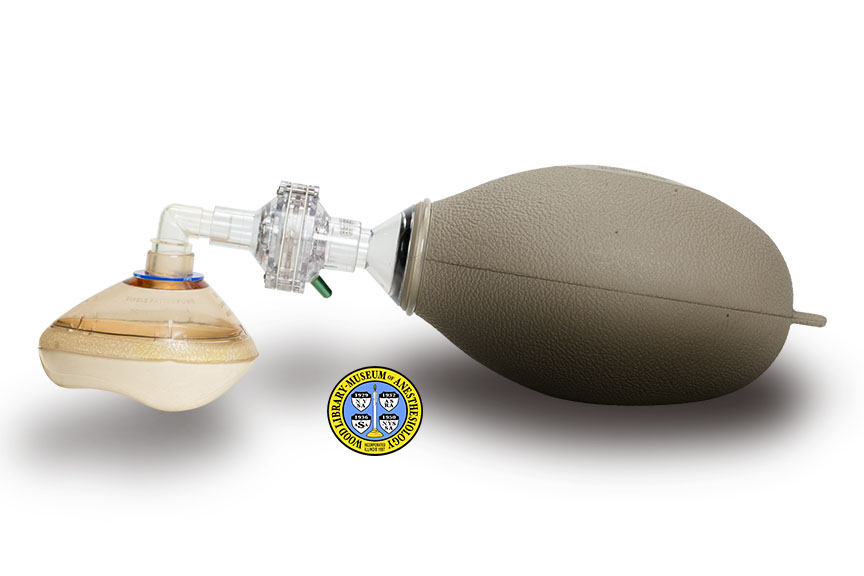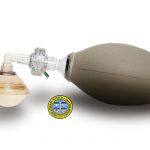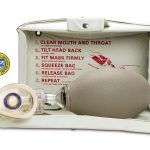Puritan Manual Resuscitator
In the operating room and other perianesthesia areas, anesthesiologists are responsible for performing and directing resuscitation. Out of a desire to provide better patient care, anesthesiologists have contributed a great deal to the development of resuscitation medicine.
Prior to the introduction of the Ambu Bag, an anesthesiologist had to use a manual bellows-like device (such as the Kreiselman Resuscitator), or rely on the availability of high pressure gas tanks or motors, to adequately refill the breathing reservoir for each patient breath. The self-inflating reservoir of the Ambu Bag, conceived by anesthesiologist Henning Ruben, M.D., revolutionized the process of manually administering respirations. Manufacturers of anesthesia equipment quickly responded by producing their own self-inflating bag-valve-mask resuscitators.
The original model of the Puritan Manual Resuscitator (PMR) was introduced by the Puritan-Bennett Corporation in the early 1960s. PMRs are used on patients who need help breathing. The mask was constructed to form a good seal around a patient’s nose and mouth, and the valve ensured that exhaled gas was directed outward so that the patient inhaled fresh air, or a mixture of air and oxygen, that was pulled into the bag as it re-inflated. The pieces of this resuscitator came in a carrying case. Instructions for using it were printed inside the case. This would have been especially useful as more laypersons became trained in basic resuscitation.
Catalog Record: Puritan Manual Resuscitator
Access Key: alut
Accession No.: 1994-04-11-1 B
Title: PMR : Puritan manual resuscitator.
Corporate Author: Puritan-Bennett Corporation.
Title variation: Alt Title
Title: Puritan’s manual resuscitator.
Title variation: Alt Title
Title: Puritan mask-valve-bag.
Publisher: [Kansas City, Missouri : Puritan[-Bennett], [between 1965 and 1990?].
Physical Descript: 1 resuscitation apparatus : silicone, plastics, cardboard, metals ; 23.5 x 38.5 x 14.5 cm.
Subject: Resuscitation – instrumentation.
Subject: Respiration, Artificial – instrumentation.
Note Type: General
Notes: The early year in the date range for the possible year of manufacture of this
resuscitation kit is an estimate based on the earliest reference to the
silicone bag (a 1965 marketing booklet) and the look of the bag in a 1967
booklet on the PMR. The end year is an estimate based on references to the
PMR in medical monographs indexed by Google Books. The date range could
change if documentation that indicates the dates should be corrected is
discovered.
Note Type: Citation
Notes: Fahey DG. The self-inflating resuscitator – evolution of an idea. Anaesth
Intensive Care. 2010;38(suppl 1):10-15.
Note Type: Citation
Notes: Operating Instructions for: Puritan Manual Resuscitator. Kansas City,
Missouri: Puritan Equipment Incorporated; 1964. [On the 6th page of the
manual it describes the resuscitator bag as being made of “closed cell
neoprene rubber.”]
Note Type: Citation
Notes: Operating Instructions for: Puritan Manual Resuscitator. Kansas City,
Missouri: Puritan Equipment Inc.; 1967. {Instructions for cleaning the valve
are on page 14.]
Note Type: Citation
Notes: PMR manual resuscitator [marketing booklet]. Kansas City, Missouri: Puritan
Equipment Division; 1965. [This booklet has the silicone bag.]
Note Type: Physical Description
Notes: One resuscitation, or artificial respiration, kit; The measurements in the
physical description field are of the case (the side with the carrying handle
was treated as the top); The carrying case for the kit is made of cardboard
and is covered in a beige colored vinyl; The shape of the case is held by
metal rivets, snaps and loops; Two small metal, reinforced holes are in the
right and left upper corners of the back of the case; A parallelogram, in
which clear plastic allows a view to the inside of the case, runs from the
lower left corner to the upper right corner of the front of the case; The
case has some marks, smudges and scratches; Marked in red on the case, in the
upper right corner of the front is, “PMR [new line] PURITAN MANUAL
RESUSCITATOR”; In the lower right corner of the front of the case the
following is marked in red, “MANUAL RESUSCITATOR”; A faded, handwritten name
is located on each side of the case, “S. BROWN M.D.”; Inside the case, on the
back, instructions are marked in red; They include, “1. CLEAR MOUTH AND
THROAT [new line] OF FOREIGN MATTER. [new line] 2. TILT HEAD BACK [new line]
LIFTING JAW. [new line] 3. FIT MASK FIRMLY [new line] OVER NOSE AND MOUTH.
[new line] 4. SQUEEZE BAG [new line] TO INFLATE LUNGS-WATCH CHEST RISE. [new
line] 5. RELEASE BAG [new line] ALLOW VICTIM TO EXHALE. [new line] 6. REPEAT
AT YOUR OWN BREATHING RATE [new line] (14 TO 20 TIMES PER MINUTE).” To the
right of these instructions is an illustration of the mask-valve-bag being
used on a patient; Below the instructions and illustrations is, “CLEAN UNIT
IMMEDIATELY AFTER USE- [new line] ALWAYS KEEP COMPLETE UNIT IN CASE”; Inside
the case are a mask, valve, and bag for administering artificial
respirations; The mask in this particular case is not the mask that would
have originally come with the kit; This mask was made by Ohio, and is a
“LARGE” or “ADULT” size; The mask has a pliable proximal side (patient’s
perspective) that is not inflatable; The material is light beige in color and
shaped to form a seal around the adult nose and mouth; The distal side of the
mask, as well as connection port, are made of a clear plastic; Also marked on
the mask, in addition to the manufacturer’s name and the size, is, “SINGLE
PATIENT USE [new line] NONCONDUCTIVE”; The mask measures (patient
perspective) approximately 12.5 x 8.7 x 11.5 cm; The valve is made of clear
and white plastics, silicone, and metals; The body of the valve is a rounded
triangle is shape (a Reuleaux triangle with rounded corners); The valve
measures (patient perspective) approximately 7 x 6.5 x 8.5 cm; On each side
is a connection; The proximal side is marked with “MASK” and “Puritan”; The
distal side is marked with “BAG”; A green colored port for oxygen extends
from the distal side; The self-inflating bag is made of a light brown colored
silicone with a clear plastic neck and bushing; The bag measures (patient
perspective) approximately 14 cm in diameter at its widest point and 28 cm in
depth; The bag is marked with, “PMR [new line] PURITAN MANUAL RESUSCITATOR”.
Note Type: Reproduction
Notes: Photographed for the WLM by Mr. Steve Donisch on January 12, 2015.
Note Type: Acquisition
Notes: Donated to the WLM by Seymour Brown, MD.
Note Type: Historical
Notes: In the operating room and other perianesthesia areas, anesthesiologists are responsible for performing and directing resuscitation. Out of a desire to provide better patient care, anesthesiologists have contributed a great deal to the development of resuscitation medicine.
Prior to the introduction of the Ambu Bag, an anesthesiologist had to use a manual bellows-like device (such as the Kreiselman Resuscitator), or rely on the availability of high pressure gas tanks or motors, to adequately refill the breathing reservoir for each patient breath. The self-inflating reservoir of the Ambu Bag, conceived by anesthesiologist Henning Ruben, M.D., revolutionized the process of manually administering respirations. Manufacturers of anesthesia equipment quickly responded by producing their own self-inflating bag-valve-mask resuscitators.
The original model of the Puritan Manual Resuscitator (PMR) was introduced by the Puritan-Bennett Corporation in the early 1960s. PMRs are used on patients who need help breathing. The mask was constructed to form a good seal around a patient’s nose and mouth, and the valve ensured that exhaled gas was directed outward so that the patient inhaled fresh air, or a mixture of air and oxygen, that was pulled into the bag as it re-inflated. The pieces of this resuscitator came in a carrying case. Instructions for using it were printed inside the case. This would have been especially useful as more laypersons became trained in basic resuscitation.
Note Type: Publication
Notes: Barnes TA, Stockwell DL. Evaluation of ten manual resuscitators across an
operational temperature range of -18 degrees C to 50 degrees C. Respir Care.
1991 Mar;36(3):161-172.
Note Type: Publication
Notes: LeBouef LL. 1980 assessment of eight adult manual resuscitators. Respir Care.
1980;25(11):1136-1142.
Note Type: Exhibition
Notes: Selected for the WLM website (noted March 30, 2015).



